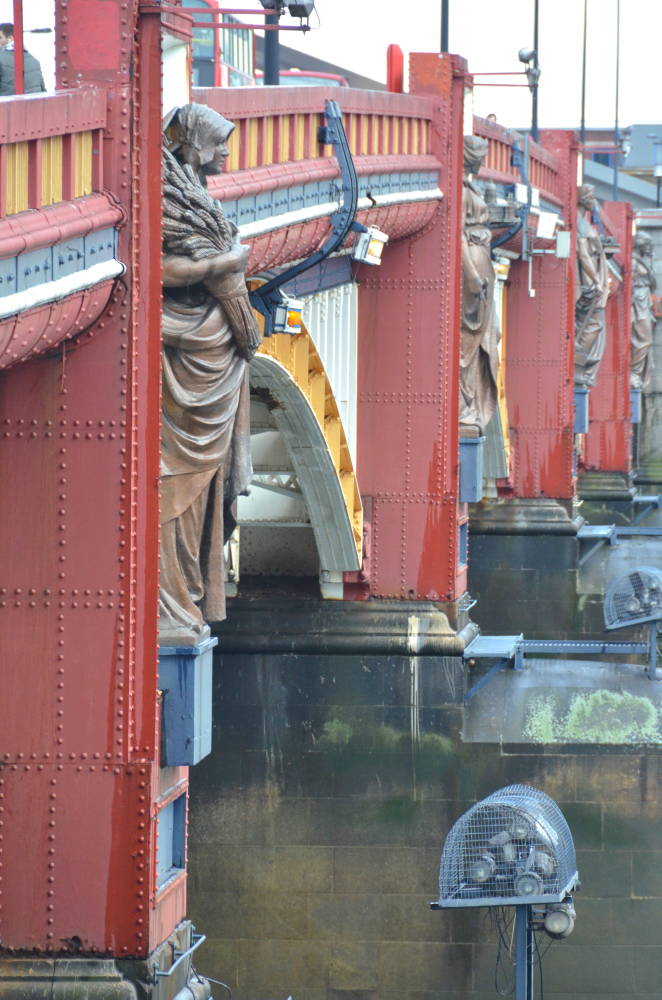
Vauxhall Bridge, London.
Vauxhall Bridge is seen here with the St George Wharf development in the background. This was the second bridge built across the Thames at this strategic location, linking Vauxhall, London SW8 to Pimlico, London SE11 — though signs of much earlier river crossings have been found in the vicinity (see "Vauxhall Bridge"). This new crossing was a challenging project, designed by two distinguished engineers, Sir Alexander Binnie (1839-1917), who was the London County Council's Chief Engineer until 1902, and his successor in that role, Sir Maurice Fitzmaurice (1861-1924). [Click on this image and those below to enlarge them.]
Various dates are given for the long process of the bridge's design and construction, 1894 being the earliest (see the list entry). Even the design went though various stages, with Binnie having to revise his original plan for a steel bridge and instead present a more traditional one, a "granite bridge backed with concrete" with "five arches, supported by four piers and suitable abutments" ("Vauxhall Bridge — A Design"). The Times reported the new plan on 24 February 1898, and demolition work duly started on the existing bridge in the following September. But there were more problems, and Binnie and Fitzmaurice had to work together to lighten the weight on the soft London clay by designing a steel superstructure after all (see Mattthews 81). The Council's official architect, William Edward Riley (1852-1937), also helped with the design of the superstructure.
Except for changes to the once-tall balustrade, the result is the bridge we have today, a Grade II* listed structure utilising the "piled footings of the earlier abutments" (Cherry and Pevsner 714). Five-spanned and steel-arched, it is 231.6m. long, its carriageway 15.2m. wide (see the list entry). It was finally opened on 26 May 1906, by the then Chairman of the London County Council, Evan Spicer (see Sheppard). An account in the Times Court Circular describes the Chairman and members of the Council, and their guests, moving on by tram from this ceremony to another, the second one being the opening of the Greenwich Electricity Generating Station. This is significant because Vauxhall Bridge was the very first bridge in central London to carry trams — initially, of the horse-drawn variety (Matthews 83). The party then returned to Vauxhall by steamboat.



A selection of the statues on the bridge piers. Left to right: (a) Pomeroy's Agriculture on the upstream side of the bridge, nearest to the Pimlico bank, showing Architecture, Engineering and Pottery beyond it. (b) Drury's Education on the downstream side, nearest to the Pimlico bank. (c) Drury's Local Government, the next statue after that.
What the LCC and their guests would not have seen, either from their tram or steamboat, was the sculptural ornamentation of the bridge. After a false start, this had been decided upon in consultation with the architect Richard Norman Shaw. Originally, Alfred Drury was to be the main sculptor, with George Frampton and Frederick Pomeroy assisting him. However, Frampton "dropped out through pressure of work" (Matthews 82), leaving Drury and Pomeroy to fulfil the commission between them. Drury took on the four statues on the downstream side, and Pomeroy took on the four on the upstream side. However, their colossal statues were not installed on the bridge's piers until 1907.
The architect Sir Reginald Blomfield had strong reservations about the placing of the statues below the level of the pedestrian and traffic thoroughfare, where the two central ones on each side, in particular, are hardly visible except from passing boats. But he did feel that a bridge should be "a symbol of the life and civilization of the people who use that bridge" (101), and the statues here do serve to reflect the life of the capital, and all that feeds into it.
The bridge is notable for several reasons. As well as scoring a first for its trams, according to the list entry again, "no other British river crossing contains sculpture" — sculpture remarkable, moreover, for its "very high quality." Much later, Vauxhall Bridge would be one of the very first thoroughfares to have a bus lane. More recently, it has been in the news again, this time for a sad reason: in December 2013 local cyclists staged a "die-in" protest at the northbound turning into it — an accident black-spot. The project that began in the Victorian period now carries an enormous volume of often dangerously fast-moving traffic.
Photographs and first caption by George P. Landow, second caption and commentary by Jacqueline Banerjee. [You may use these images without prior permission for any scholarly or educational purpose as long as you (1) credit the photographer and (2) link your document to this URL.]
Related Material
- T. R. Way's Vauxhall Bridge (lithograph, 1899, showing the previous bridge)
- Pomeroy's Agriculture
- Pomeroy's Architecture
- Pomeroy's Engineering
- Drury's The Fine Arts
- Drury's Science
- Drury's Education
- Drury's Local Government
Sources
Blomfield, Reginald. "The Bridges of London, 1815-1920." In London of the Future, ed. Sir Aston Webb. London: T. Fisher Unwin, 1921. Internet Archive. Web. 28 December 2013.
Brodie, Antonia. Dictionary of British Architects 1834-1914. Vol. 2, L-Z. London: Continuum, 2001. Print.
Cherry, Bridget, and Nikolaus Pevsner. London: South. Buildings of England series. New Haven and London: Yale University Press, 2002. Print.
Court Circular. The Times. 26 May 1906: 14. Times Digital Archive. Web. 28 December 2013.
"List Entry: Vauxhall Bridge." English Heritage. Web. 28 December 2013.
Matthews, Peter. London's Bridges. Princes Risborough: Shire, 2009. Print.
Sheppard, F. H. W., ed. Vauxhall and South Lambeth: Vauxhall Escheat." Survey of London: Vol. 26: Lambeth: Southern area (1956): 73-80. British History Online. Web. 28 December 2013.
"Vauxhall Bridge." The Vauxhall Society. Web. 28 December 2013.
"Vauxhall Bridge — A design for the new." The Times. 24 February 1898: 12. Times Digital Archive. Web. 28 December 2013.
Last modified 28 December 2013